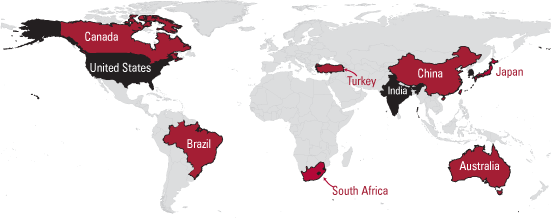International Outlook for 2014
Clinical Assistant Professor of Business Economics and Public Policy, Kelley School of Business, Indiana University Bloomington
The overall international economy will be stronger in 2014 than it is in 2013. Globally, GDP is forecasted to increase 3.6 percent in 2014, and is currently predicted to achieve a growth of 2.9 percent in 2013. This article will address the main reason the world economy seems to be stuck in low gear and is forecasted to experience moderate growth in 2014. It will also expose the global economy’s weaknesses in the medium-term by outlining the shortcomings of the economies relied upon to uphold global growth.
Figure 1: Countries Discussed in the 2014 International Economy Outlook

Source: Indiana Business Research Center
World Output
In 2014, world output will once again be predominantly supported by more advanced economies rather than growth from emerging and developing markets. The more advanced economies are slowly strengthening and expected to grow 2 percent in 2014. Despite repetitive efforts from U.S. politicians in Washington to sabotage the recovery, U.S. news is encouraging. The panic in Europe has somewhat receded as the peripheral countries are not as likely to default, the core European countries are slowly getting out of the recession, and other developed economies around the globe, such as Canada, Australia and Japan are steadily growing. The emerging markets (which had been the engine of growth in the recent past) are still growing but moderately weakening. This is particularly the case for India, Brazil and Turkey. China is still showing a solid 7.3 percent growth rate and its slowdown from double-digit growth rates has been orderly and deliberately gradual.
The risk to the global forecast remains down, but the most significant threat to the world economy will be in the second half of 2014. The Federal Reserve System will likely exit from both quantitative easing and zero policy rates and many economies’ fundamentals will be tested.
Global Trade
One metric to assess global health is the volume of global trade. Five years ago the financial tsunami in the United States was transmitted globally through the trade channel. International trade fell to record lows and only recovered because of the coordinated global stimulus and a growing Chinese appetite for imports. 2010 marked the end of the global recession and many economists made a mistake: they expected the world’s output to strongly bounce back and stabilize at more than 4 percent annual growth rate, a very optimistic expectation. However, households decided to pay back their debt, advanced economies shifted from fiscal stimulus to austerity, and many economies’ structural deficiencies surfaced. The main reason the optimistic forecast on global growth did not materialize was the less-than-stellar world trade recovery. In the past year and a half, world trade has barely grown (about 2 percent), and is well below its 20-year average of 5.4 percent. The necessary force of global recovery is missing.
In 2008, through contagion from the United States, Europe faced its own financial meltdown, which undeniably placed the European Union (EU) economies at the heart of an eventual trade implosion. Since the EU consumes roughly one third of the world’s traded goods, when it is in meltdown mode, the world simmers as well. Specifically, Europe’s subsequent bailouts exposed their structural problems: sovereign debt, a weak banking system, income distribution issues and mismatched labor market skills. These mismatched skills are uneven throughout the continent, most notably in the south and periphery European countries.
Through the trade channel, Europe’s 2008 macroeconomic shock is now rippling to the EU’s major trading partners in Asia, opening channels for the shock to spread well beyond developed economies. Subsequently, decelerating Asian growth is decreasing the demand for commodities flowing to the Asian market, which are usually sent from emerging economies such as Brazil or South Africa. In the early years of the crisis, the Asian powerhouses and their major trading partners were hailed for their resilience as their robust growth carried the rest of the world. Today, however, the Asian powerhouses and trading partners are faced with sluggish demand for their natural resources. Under the microscope of weak demand, these economies are revealing their immaturity and potential structural flaws.
Monetary Policy
In June 2013, The Federal Reserve announced that it may end ‘easy-money’ (monetary stimulus). The Fed’s announcement to end easy money quickly created volatility in markets in Brazil, India and Turkey. These countries’ quick jump to volatility and the rapid decrease in the value of their currencies indicates that possible structural flaws exist in their economies. The currency depreciation alone is not a source of worry. The widening trade deficit that intensifies the risk of a balance-of-payment crisis in those countries causes concern. Further heightening the risk is that during the years of easy money the countries did not invest in infrastructure building or foundations for productivity growth.
Looking specifically at India, we can further dissect the possible structural flaws. India’s vulnerability to volatility in the global capital market needs to be met by more rational policy measures. Namely, the policies need to focus on macroeconomic fundamentals, pro-growth, anti-inflationary measures and pro-government savings.
Likewise, the weakening inward capital flows in Brazil has led to the depreciation of the real, creating inflationary pressures while the economy is contracting. Concurrent to the weak capital flows, Brazil’s lack of industrial diversification and persistent reliance on natural resource exports has exposed their economy to the Chinese slowdown known as “Chindown.” Chindown is the self-engineered and official Beijing policy of weaning itself off commodity-hungry growth, meaning it is demanding fewer Brazilian resources. Some might think that Chindown’s impact on Brazil could be lessened somewhat by the capital expenditures revolving around hosting the FIFA World Cup in 2014, as the infrastructure building represents a great opportunity for the longer-term. However, rampant corruption has been revealed in the sixth greatest economy in the world, and often higher corruption is associated with stunted economic performance in the longer-term.
Finally, shifting focus to Turkey, we also see signs of structural flaws. Namely, the Turkish economy is one of the most vulnerable to a sudden stop of capital inflows. This vulnerability is due to its large capital account deficit and large holding of foreign denominated debt. Although they were left unscathed by the global recession, as the time of un-easy money approaches we see that Turkey’s robust growth is at the mercy of credit-fueled consumers. Finally, this traditionally boom-and-bust economy is located in a very hazardous geopolitical position. Turkey shares an 822 kilometer border with Syria, a 499 kilometer border with Iran and only approximately 3 percent of its land is in Europe.
Global Forecast
The world in 2014 will once again face an important economic transition as there remains no possibility for easy money and fiscal stimulus to continue. The global economy will remain interdependent and there are large gains to be realized through intelligent coordination. It is time for world policymakers to create an environment more conducive to market forces. Years of easy money have only been successful in stabilizing financial markets, but they have not achieved strong and sustainable growth. There is a legitimate fear that our leaders will retreat into spaces that are constrained by their own domestic politics and this will continue to fuel frustration of many throughout the world. Poor politics will continue to destabilize even good economies.




